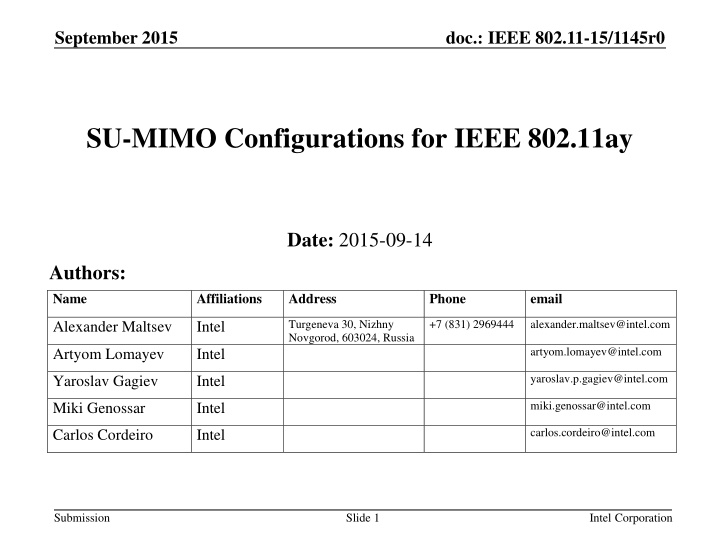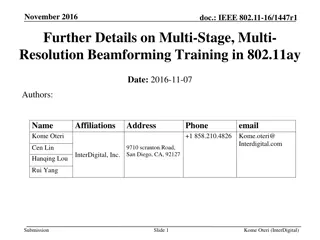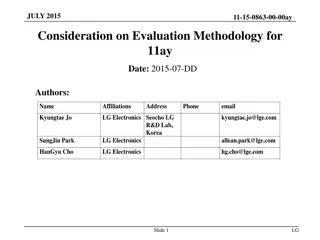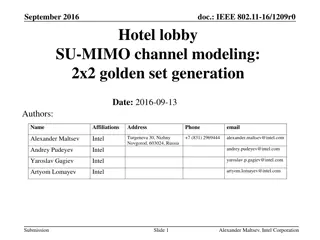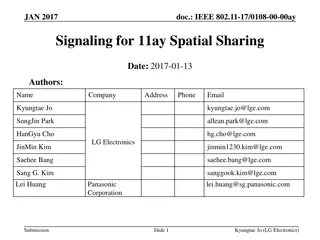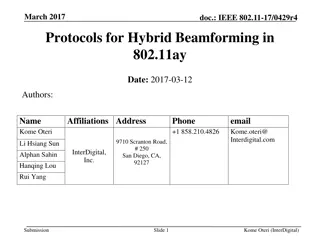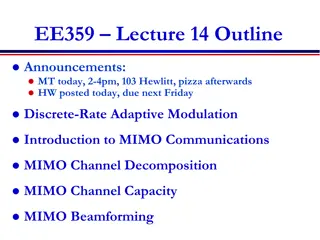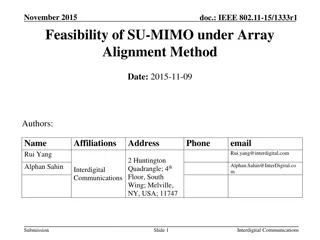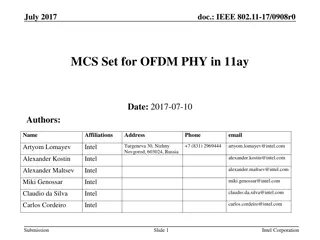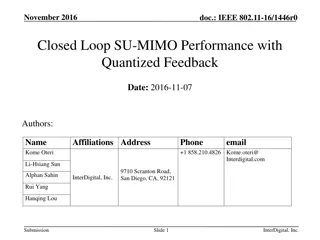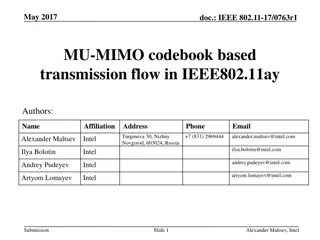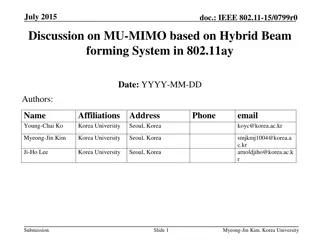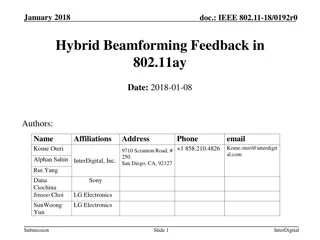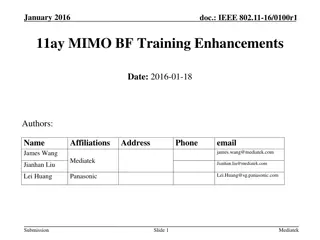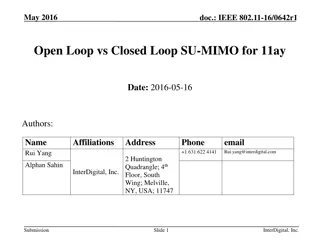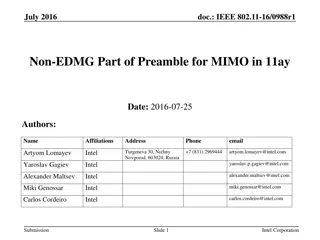SU-MIMO Configurations for IEEE 802.11ay Standard
This presentation discusses SU-MIMO configurations proposed for inclusion in the IEEE 802.11ay standard. These configurations leverage spatial and polarization diversity channel properties to enable operation in various conditions, supporting the development of evaluation methodologies. Topics covered include single array MIMO with single and dual polarization, as well as multi-array MIMO setups.
Download Presentation

Please find below an Image/Link to download the presentation.
The content on the website is provided AS IS for your information and personal use only. It may not be sold, licensed, or shared on other websites without obtaining consent from the author.If you encounter any issues during the download, it is possible that the publisher has removed the file from their server.
You are allowed to download the files provided on this website for personal or commercial use, subject to the condition that they are used lawfully. All files are the property of their respective owners.
The content on the website is provided AS IS for your information and personal use only. It may not be sold, licensed, or shared on other websites without obtaining consent from the author.
E N D
Presentation Transcript
September 2015 doc.: IEEE 802.11-15/1145r0 SU-MIMO Configurations for IEEE 802.11ay Date: 2015-09-14 Authors: Name Affiliations Address Phone email +7 (831) 2969444 Turgeneva 30, Nizhny Novgorod, 603024, Russia alexander.maltsev@intel.com Alexander Maltsev Intel artyom.lomayev@intel.com Artyom Lomayev Intel yaroslav.p.gagiev@intel.com Yaroslav Gagiev Intel miki.genossar@intel.com Miki Genossar Intel carlos.cordeiro@intel.com Carlos Cordeiro Intel Submission Slide 1 Intel Corporation
September 2015 doc.: IEEE 802.11-15/1145r0 Abstract This presentation describes SU-MIMO configurations proposed to be included in IEEE 802.11ay standard. These configurations exploit spatial and polarization diversity channel properties and allow system operation in LOS and NLOS conditions. The considered configurations should be supported by appropriate channel models and facilitate evaluation methodology development. Submission Slide 2 Intel Corporation
September 2015 doc.: IEEE 802.11-15/1145r0 Single Array MIMO with Single Polarization Single array MIMO uses single Phased Antenna Array (PAA) of M x N rectangular geometry. All PAA elements have identical linear polarization of type H (horizontal) or V (vertical). Each PAA element is fed with a superposition of weighted (or phase shifted) signals pertained to different streams to create a desired resulting antenna pattern. This scheme exploits spatial channel diversity property and separates the streams in space domain maximizing the received power (finding strong reflector) and minimizing the impact of each stream on others (interference suppression). Figures at the left show an example of PAA of size 4 x 8 and supply chain for each PAA element in case of 2 transmit MIMO streams. This scheme can potentially work in NLOS environment, however in LOS environment two streams will be spatially correlated, therefore poor MIMO performance is expected. Each element has single polarization V pol H pol or E E Phase shifter Signal 1st stream PAA element Signal 2nd stream Submission Slide 3 Intel Corporation
September 2015 doc.: IEEE 802.11-15/1145r0 Single Array MIMO with Dual Polarization Single array MIMO with dual polarization uses single PAA of rectangular geometry of size M x N. Each PAA element has dual linear polarization H (horizontal) and V (vertical). This scheme exploits polarization diversity property and can assign two streams to different H and V polarizations. Figures at the left show an example of PAA of size 4 x 8 and supply chain for each PAA element in case of 2 transmit MIMO streams. This scheme can potentially work in LOS and NLOS environments. The beamforming algorithm in NLOS can use single reflection (one spatial direction) for both streams or two strong reflections (two spatial directions). It can be selected by phase shifters. Each element has dual polarization V and H pol E Phase shifterV pol Signal 1st stream PAA element Signal 2nd stream H pol Submission Slide 4 Intel Corporation
September 2015 doc.: IEEE 802.11-15/1145r0 Multi-Array MIMO Multi-array MIMO uses K physically independent PAAs with single or dual polarization type. Figure at the left shows an example of 2 PAAs separated by the distance d. The PAA #1 and PAA #2 arrays can use elements with single or dual polarization as considered at the previous slides. In case of dual polarization arrays this system can implement 4 x 4 MIMO scheme with 4 spatial streams. This scheme can work environments. The possibility to use 4 x 4 MIMO scheme in LOS environment depends on the PAAs separation d, antenna arrays size, and the distance between TX and RX, [1]. Each PAA can do independent beamforming search or cooperative search to find the best channel realization. Distance between array centers - d PAA #2 in LOS and NLOS PAA #1 Each element can have single (H or V) polarization Each element can have dual (H and V) polarization Submission Slide 5 Intel Corporation
September 2015 doc.: IEEE 802.11-15/1145r0 SU-MIMO Configurations Configuration #1: single array, single polarization, 2 streams Device 1 and device 2 have the same configuration: Examples of beamformed links: Each element has single polarization V pol H pol Device #1 Device #2 or Beam #1 E E Beam #2 H or V pol H or V pol Device #1 Device #2 Beam #1 Phase shifter Signal 1st stream Beam #2 PAA element H or V pol H or V pol Signal 2nd stream Submission Slide 6 Intel Corporation
September 2015 doc.: IEEE 802.11-15/1145r0 SU-MIMO Configurations (Cont d) Configuration #2: single array, dual polarization, 2 streams Device 1and device 2 have the same configuration: Examples of beamformed links: H Each element has dual polarization Device #1 Device #2 Device #1 Device #2 V and H pol H Beam #1 E V Beam #2 V H and V pol H and V pol H and V pol H and V pol H H Device #1 Device #2 Device #1 Device #2 Phase shifterV pol Beam #1 V Signal 1st stream PAA element Beam #2 V Signal 2nd stream H and V pol H and V pol H and V pol H and V pol H pol Submission Slide 7 Intel Corporation
September 2015 doc.: IEEE 802.11-15/1145r0 SU-MIMO Configurations (Cont d) Configuration #3: dual array, single polarization, 2 streams Device 1 and device 2 have the same configuration: Examples of beamformed links: Device #1 Device #2 Device #1 Device #2 Distance between array centers - d PAA element Signal 2nd stream d2 d1 d2 d1 Phase shifter PAA element H or V pol H or V pol H or V pol H or V pol Signal 1st stream PAA #2 Phase shifter V pol H pol or Device #1 Device #2 PAA #1 Device #1 E E Device #2 V pol H pol or d2 d1 d2 d1 E E H or V pol H or V pol H or V pol H or V pol Submission Slide 8 Intel Corporation
September 2015 doc.: IEEE 802.11-15/1145r0 SU-MIMO Configurations (Cont d) Configuration #4: dual array, dual polarization, 4 streams Device 1 and device 2 have the same configuration: Examples of beamformed links: H Device #1 Device #1 Device #2 Device #2 Phase shifter H V V pol Distance between array centers - d Signal 3rd stream V PAA element d2 d1 d2 d1 H Signal 4th stream V V H H pol H and V pol H and V pol H and V pol H and V pol Phase shifterV pol PAA element Signal 1st stream Signal 2nd stream PAA #2 Device #1 H Device #2 Device #1 Device #2 H pol V PAA #1 d2 d1 d2 d1 H H and V pol V H and V pol H and V pol H and V pol H and V pol H and V pol Submission Slide 9 Intel Corporation
September 2015 doc.: IEEE 802.11-15/1145r0 SU-MIMO Configurations (Cont d) Configuration #5: single array, single to dual polarization, 1 stream Device 1 configuration: Examples of beamformed links: V pol H pol or Device #1 Device #2 PAA element E E Signal 1st stream Phase shifter PAA #1 H or V pol H and V pol Device 2 configuration: Device #1 Device #2 Phase shifterV pol PAA element Signal 1st stream H and V pol Signal 1st stream H or V pol H and V pol H pol PAA #1 Submission Slide 10 Intel Corporation
September 2015 doc.: IEEE 802.11-15/1145r0 Summary of SU-MIMO Configurations Table below summarizes the SU-MIMO configurations. PAA has rectangular geometry of M x N and distance between arrays d1, d2. M, N, and d1, d2 are parameters. # Number of data streams MIMO configuration Number of PAAs (Device 1, Device 2) Polarization type (Device 1, Device 2) PAAs separation (Device 1, Device 2) Number of RF parts per PAA (Device 1, Device 2) LOS NLOS Mandatory / Optional* 1 2 2 x 2 (1, 1) (Single, single) (0, 0) (2, 2) No Yes Optional 2 2 2 x 2 (1, 1) (Dual, dual) (0, 0) (2, 2) Yes Yes Mandatory 3 2 2 x 2 (2, 2) (Single, single) (d1, d2) (1, 1) Yes Yes Mandatory 4 4 4 x 4 (2, 2) (Dual, dual) (d1, d2) (2, 2) Yes Yes Optional 5 1 1 x 2 (1, 2) (Single, dual) (0, 0) (1, 2) Yes Yes Mandatory *Mandatory / optional classification is applied in relation to the channel modeling. Submission Slide 11 Intel Corporation
September 2015 doc.: IEEE 802.11-15/1145r0 MIMO Modes Evaluation In accordance with contribution IEEE doc. 11-14/0606r0 (ref. [2]), different MIMO techniques can be evaluated for the proposed MIMO configurations, including: Maximum Ratio Combining (MRC) robust transmission Open-Loop (OL) MIMO/STBC, optimal selection from: OL MIMO (two streams, double rate) Alamouti space-time coding scheme Closed-Loop (CL) MIMO: SVD fine subcarrier-wise beamforming The evaluation of these techniques should be done in reliable channel models that will be developed for the proposed MIMO configurations and approved use cases. Submission Slide 12 Intel Corporation
September 2015 doc.: IEEE 802.11-15/1145r0 Conclusions This work proposes SU-MIMO configurations to be used to support channel models, evaluation methodology, and standard development in IEEE 802.11ay group. It is proposed to consider MIMO schemes utilizing one or two Phased Antenna Arrays (PAAs) with rectangular geometry. Each element of the PAA can have single linear (H or V) polarization or dual (H and V) polarization. The considered schemes exploit spatial and polarization diversity channel properties and allow system operation in LOS and NLOS conditions. The maximum SU-MIMO configuration is limited to 4 x 4 scheme and supports 4 streams. Submission Slide 13 Intel Corporation
September 2015 doc.: IEEE 802.11-15/1145r0 References A. Maltsev, et al, Experimental Measurements for Short Range LOS SU-MIMO, IEEE doc. 11-15/0632r1. C. Cordeiro, et al, Next 30+ Gbps WLAN, IEEE doc. 11-14/0606r0. Rob Sun, et al, IEEE 802.11 TGay Use Cases, IEEE doc. 11-15/0625r2. 1. 2. Generation 802.11ad: 3. Submission Slide 14 Intel Corporation
